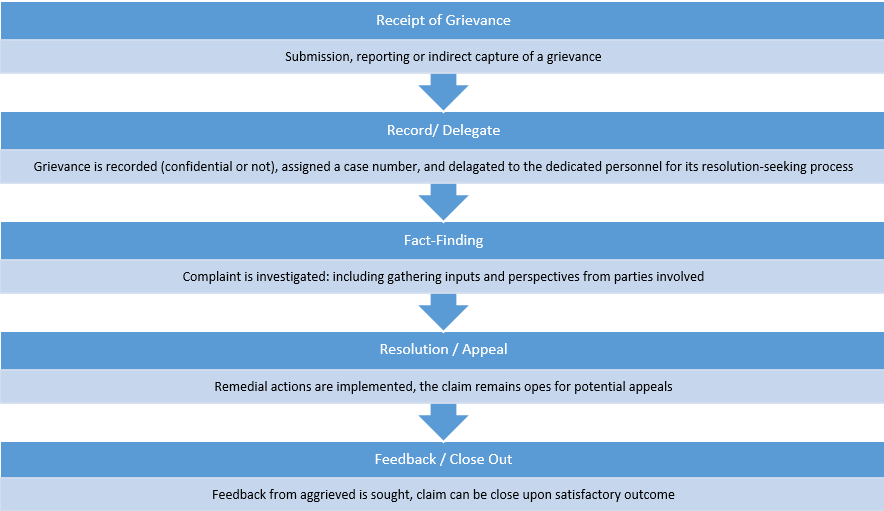A Grievance Redress Mechanism is to receive and facilitate resolution of affected stakeholders’ concerns and grievances related to the Project’s environmental and social performance. The GRM process should be disclosed publicly and available during the pre-construction, construction and operation phases of the Project, and to be used by all affected stakeholders, including employees and contractors.
Grievances should be received, recorded/ documented and addressed in a manner that is easily accessible, culturally appropriate and understandable to affected communities. Where feasible and suitable for the Project, the grievance mechanism may utilize existing formal and informal grievance mechanisms, that will support the Project-specific proposed arrangements. The Project dedicated personnel on handling grievances will be consistent, experienced and qualified to do so.
The communities will be informed about the GRM during the stakeholder consultation and disclosure activities. The mechanism will be communicated and made available to all affected communities and in particular to both genders and vulnerable groups.
The Project dedicated personnel will be experienced and/or trained to seek solutions to complaints in a collaborative manner with the involvement of the affected community, taking into consideration customary and traditional methods of dispute resolution, and not impeding access to existing judicial or administrative mechanism available in the country for resolution of disputes. The mechanism includes a redress aspect so that those who feel their complaint has not been addressed in a manner they find satisfactory can have recourse to an external body for reconsideration of their case.
Concerns will be addressed promptly, using a transparent process that is readily accessible to all segments of the affected communities and at no cost to them and with no retribution. Grievances received and responses provided will be reported back to the community periodically (at least every six months).
The Project will provide an option for anonymous grievances, including for worker grievances whereby the worker’s identity can be protected from their supervisor or any repercussions.
The following Figure 5. Grievance Redress Mechanism Tracking summarises the GRM process. Timings per stage will be agreed with the DOE and included in the disclosure to communities.

DOE has selected a GRM Focal :
Grievance Redress Mechanism focal : Anthony Garae , Tel : +678 25201 | 33425 ,
The GRM Focal Point’s contact details are available to all stakeholders.
Grievances can be made by anyone to the GRM Focal Point within DOE.
The GRM Focal Point will work with DOE officers to support the handling of complaints brought to the attention of the GRM Focal Point and will be the secretary of the Grievance Management Committee
The Grievance Management Committee, consisting in the GRM Focal Point, the DOE offices supporting the handling of complaints, representatives from the Project development, is tasked with discussing and steering how to address issues / complaints. The Grievance Management Committee should gather when issue / complaint are received and in any case on a monthly basis.
- Anyone can raise complaints, grievances, concerns, ask questions or make comments or suggestions related to the Project;
- Anyone can contact the GRM focal point using the GRM focal point’s contact details provided above;
- the GRM focal point is responsible for receiving complaints, grievances, concerns, questions, comments, suggestions, and for responding to the person on a non-anonymous basis or generally via the Project’s website on an anonymous basis;
- the GRM focal point will confirm receipt of the complaint, grievance, concern, question, comment, suggestion, either providing a preliminary answer or confirming the expected timing to provide an answer; and
- by using this grievance mechanism, the complaint, grievance, concern, question, comment, suggestion with respect to the mini grid Project development will be received by the Project proponent which will endeavour to answer the complaint, grievance, concern, question, comment, suggestion and engage with the complainee and the Project’s other relevant parties to mitigate any complaint, grievance, concerns, or incorporate any comment, suggestion in the Project development to the extent possible.
ANNEX A to EoI Form: Basic requirements for the sub-project proposed site(s)
Overview of a VREP II mini-grid system:
Mini-grids are small-scale electricity infrastructure systems requiring limited land area. Land is required for several components as follows:

- Photovoltaic (PV) array–under the Project, the PV arrays are likely to be ground-mounted; however there may be an option to install panels on roofs of community buildings if mechanical cyclone resistance can be achieved. The PV array will comprise the largest piece of infrastructure by area; but it is expected that such area will range between 600 and1200 m2 (equivalent to a tenth to up to one football pitch);
- Battery storage and bio/diesel generator (genset) – these facilities will likely be housed together within a small building adjacent to the PV array. The below picture shows an example of a PV array and battery/genset building similar in scale to that being considered under VREP II. Inverters and transformers are small pieces of equipment needed in a mini-grid system that can also be housed within the battery/genset building;
- Distribution system– this will comprise power poles or easement for underground cables, wires and household electricity meters. The footprint of pole foundations is approximately one square metre (m2) and electricity meters are the size of a shoe box.
Criteria to select a good project site for the PV Array:
- Government-owned land preferably (if not, church land, if not, customary/ private land)
- Minimum area of 600 m2
- Flat topography
- Close to the village and easily accessible
- Minimum shade during most of the day
- Clear from vegetation or with light vegetation
- No trees of conservation significance within the proposed area
- Not too close to sacred sites
- Not too close to burial sites or cemetery
- Not too close to water sources
- Not at risk of flooding
- Not next to any existing electricity or production related infrastructure
- Not directly impacted an Eco sensitive habitat (e.g. a mangrove)